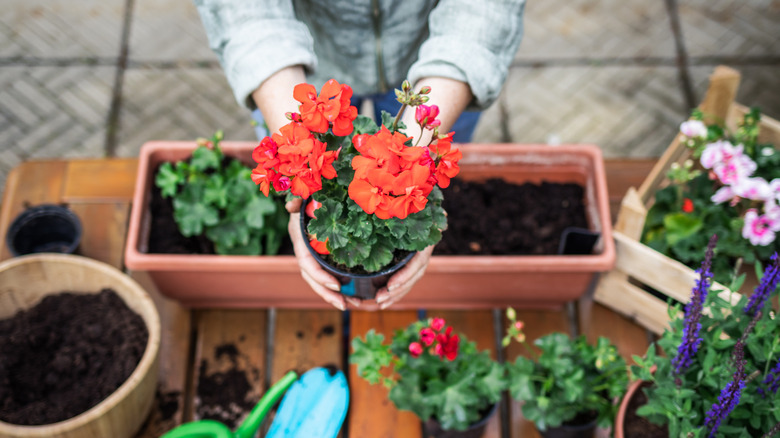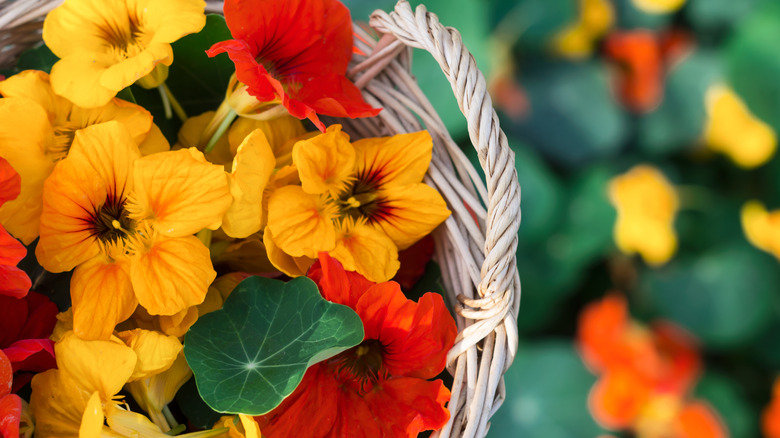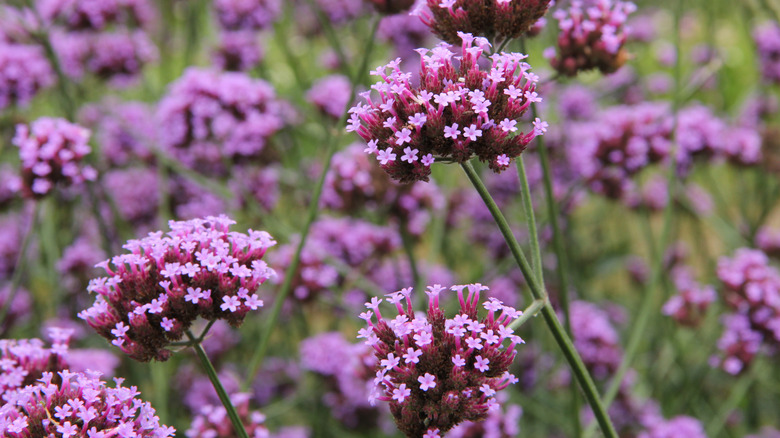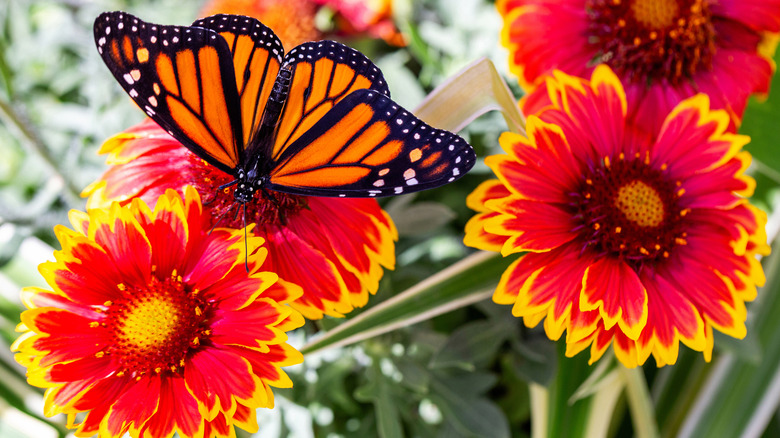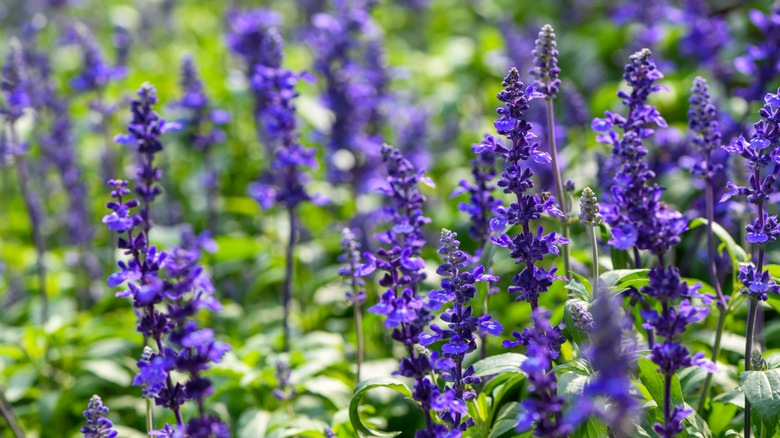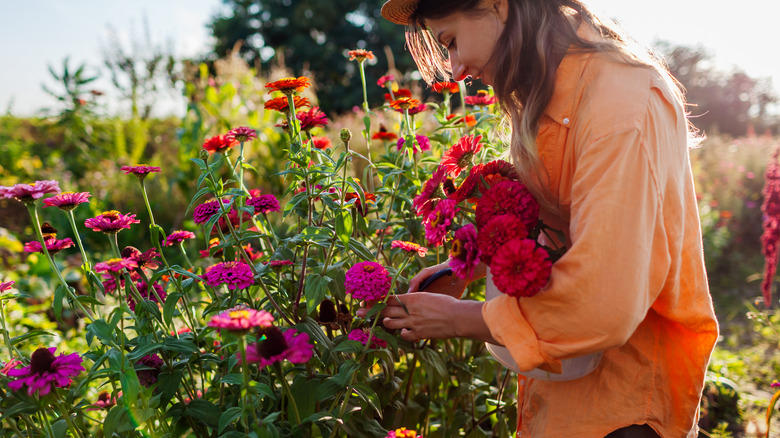The Best Companion Plants For Geraniums To Boost Your Garden's Appearance
Geraniums (Pelargonium x hortorum) are easy to grow, come in a number of vibrant colors, and are used as an insect repellent. Depending on the variety, they can grow from 6 inches up to several feet, giving them versatility in garden beds, hanging baskets, and containers. Available in pink, red, white, and orange shades, they also make popular potted gifts — for their beauty, but also their symbolism of friendship, good health, happiness, and positive emotions.
These popular flowers grow in USDA Hardiness Zones 9 through 12. They are happiest with at least four hours of direct sunlight each day. In areas with intense heat, the plants may need some reprieve, benefiting from shade during peak sun hours. Geraniums do best in well-draining soil that can dry up between waterings. However, pay close attention and water them before they wilt, which can lead to yellowing leaves. If this seems to happen often, consider upsizing the container to make space for a strong root system and to allow the soil to hold enough water.
You could plant geraniums on their own, but you should know that they also even more dazzling when growing alongside other plants, like nasturtium, zinnia, or salvia. Stick with similar hues — for example, all red and magenta — in one container, or complement pale pink and salmon with cool colors, like blues, purples, or chartreuse. Here are some options for companion plants to create stunning garden displays.
Nasturtiums
Nasturtiums (Tropaeolum) come in red, orange, yellow, or cream, keeping with a theme of bright warm hues when combined with similarly colored geraniums. A perennial in zones 9 to 11, nasturtiums thrive in full sun and can tolerate drier soil, similar to geraniums. They also benefit from some shade in particularly hot climates. Trailing nasturtiums, like the Tropaeolum magus 'Jewel of Africa,' will spill over a hanging basket below upright geraniums. Even if you live outside the growing zone, as annuals, they will reseed themselves every year. Bonus: The edible petals and leaves add a peppery kick to food.
Verbena
Verbena, beloved by pollinators, match the geraniums' bloom time spanning from spring to the first frost. They tolerate zones 4 through 11. Available in white, pink, red, purples, and blues, you'll find a color combination that works well with geraniums. Moss verbena (Verbena aristigera) has a sprawling growth habit, punctuated by bluish-purple flowers that complement the taller blooms of the geranium. While this duo can tolerate heat, both of them wane if they are too dry for too long. Water them at the base of their plants rather than overhead, as wet foliage leaves both plants susceptible to disease.
Blanket flower
The blanket flower (Gaillardia) grows in zones 3 through 10 and resembles the shape and cheerful colors of daisies; however, they belong to the sunflower family. Blanket flowers — maxing out at 1 to 2 feet — come in yellow, orange, red, and burgundy, and often showcase multiple colors that stand out against fuzzy gray-green leaves. Blanket flowers need good drainage and full sun, and work well with other plants, like geraniums, that prefer dry conditions. Deadheading the blanket flower can produce more blooms. One caveat: If you have sensitive skin, the plant is known to cause skin irritation.
Salvia
More than 1,000 species of salvias exist and typically grow in zones 4 through 10 — including sage. Some can grow up to 4 feet tall, so choose the right variety for the space you're working with. The general care of the salvia plant is similar to geraniums, both needing full sun and well-drained soil. A shorter variety like Salvia farinacea 'Victoria Blue' can grow up to 20 inches and spread up to 1 foot. The towers of indigo flowers rise above light-green foliage, perfectly contrasting with bright red geraniums. This salvia blooms from late spring through the first frost.
Zinnias
Zinnias (zones 3 through 10) are an obvious choice for something with brilliant color that can tolerate heat, and the abundant flower variety keeps gardeners from getting bored. The blooms fall into three categories: Single (one row of petals and a visible center), double (multiple rows of petals with a hidden center), and semidouble (layers of petals around a center). Zinnias come in many colors, including the chartreuse Zinnia elegans 'Green Envy.' They need well-drained soil and at least eight hours of full sun. Prune zinnias for a bounty of colorful cut flowers or try propagating cuttings in water.
